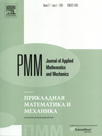 | | Journal of Applied
Mathematics and Mechanics
Russian Academy of Sciences | | Founded
in January 1936
(Translated from 1958)
Issued 6 times a year
ISSN 0021-8928
(print version) |
Archive of Issues
| Total articles in the database: | | 10482 |
| In Russian (ΟΜΜ): | | 9683
|
| In English (J. Appl. Math. Mech.): | | 799 |
|
| << Previous article | Volume 80, Issue 5 / 2016 | Next article >> |
| Ye.M. Zveryayev, "A consistent theory of thin elastic shells," J. Appl. Math. Mech. 80 (5), 409-420 (2016) |
| Year |
2016 |
Volume |
80 |
Issue |
5 |
Pages |
409-420 |
| DOI |
10.1016/j.jappmathmech.2017.02.008 |
| Title |
A consistent theory of thin elastic shells |
| Author(s) |
Ye.M. Zveryayev (Keldysh Institute of Applied Mathematics of the Russian Academy of Sciences, Moscow, Russia, zveriaev@gmail.com) |
| Abstract |
The process of constructing a theory of thin elastic shells by the simple iteration method is described. The convergence of this method is ensured by the contraction mapping principle. The three-dimensional equations of the elasticity theory in curvilinear coordinates are reduced to a form that, in accordance with the semi-inverse Saint-Venant method using a specified part of the stresses and displacements, enables the calculation of the remaining unknowns and the correction to the given data. Six boundary conditions on the faces determine three non-tangential stresses using the given surface loads. Two iterative processes are selected. As a result of satisfying the boundary conditions on the faces with the stresses of the first process, five equations of the statics are obtained that are identical to the classical equations apart from quantities of the next order of smallness. After satisfying the conditions on the faces, the unknowns calculated as the result of the second process, along with the quantities from the first process, give improved Timoshenko-Reissner-type equations, allowing the three boundary conditions on each end surface to be satisfied. Unlike in the classical theory, all the unknowns in a problem of the elasticity theory are calculated. The boundary conditions on the faces are satisfied by non-tangential stresses that are neglected in the classical theory. |
| Received |
24 December 2015 |
| Link to Fulltext |
|
| << Previous article | Volume 80, Issue 5 / 2016 | Next article >> |
|
 If you find a misprint on a webpage, please help us correct it promptly - just highlight and press Ctrl+Enter If you find a misprint on a webpage, please help us correct it promptly - just highlight and press Ctrl+Enter
|
|

 Russian
Russian  English
English